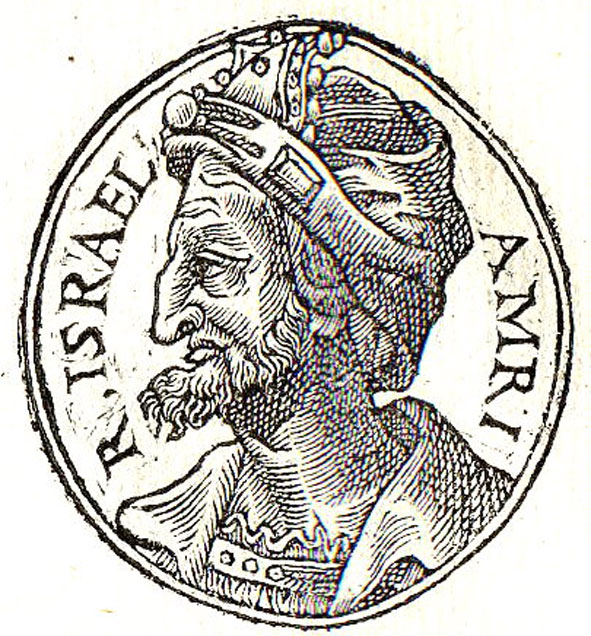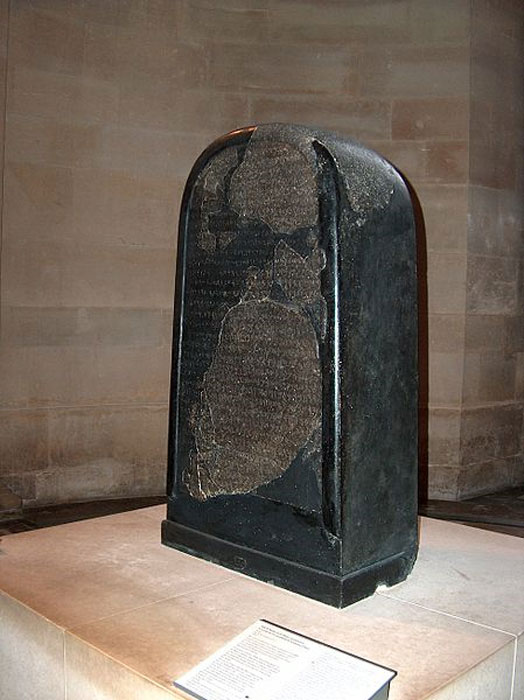
This 2,800-Year-Old Stele Tells A Bible Story From A Different Point Of View
As soon as you fit the words “Bible” and “history” into the same sentence, people start reacting. Most people are in one of two camps: either every word of the Bible is completely, literally true, or else the whole thing is a made-up fairy tale.
The truth, though, is a bit more complicated. There are stories in the Bible that we know for a fact really happened. We have found ancient tablets created by other countries that tell the same stories written in the Bible - proof that these things really happened.
But they’re never exactly the same. The people who went to war against Israel don’t write about how great Israel is – they tell the story from their own point of view. And from the other side, it’s always a little bit different.
Case and point: the Moabite Stele, a 2,800 year-old stone slab that tells the story of 2 Kings 3, about a war between the kingdom of Moab and Israel. The author of this stone slab, though, is the King of Moab – and from his point of view, he wasn’t some evil, pagan warlord. He was a hero.
- Serpent Stones: The Vishap Steles of Armenia as a Symbol of Rock Art and Rich Heritage
- 4 Completely Different Versions of the Story of Moses
Israel The Oppressor
The Biblical story doesn’t give a lot of details about why the war started. It mentions that Moab was “rebelling” against Israel, and it suggests that God let it happen to punish the Israelites for worshiping false idols – but it doesn’t really worry itself with what Moab’s grievances might be.
The Moabite Stele, though, was written by Mesha, the King of Moab – and he’s very clear about it. “Omri, King of Israel, oppressed Moab many days,” he writes. Israel, it seems, invaded a Moabite city called Medeba. Mesha’s father had tried to negotiate with him peacefully, but when he asked the Israelites to let Medeba go, the Israelites threatened to “destroy it forever”.

Depiction of Omri from Guillaume Rouillé's ‘Promptuarii Iconum Insigniorum’. (Public Domain)
The Moabites, it seems, had been putting up with this kind of thing for a while. Medeba wasn’t the first city they’d taken – it was just the last straw. About a dozen cities are listed as towns that Israel stole from the Moabites, meaning that they’d been slowly encroaching on Moabite land for years.
It fills in some gaps in the Biblical record. The town Nebo, for example, is first mentioned in the Bible as a Moabite town where Moses died. The next time we hear about it, though, is in a verse complaining that the Moabites have “despoiled” it and “taken” it from Israel.

Detail of a portion of lines 12–16. The middle line (14) reads "Take Nabau (Nebo) against Israel." (Mbzt/CC BY 3.0)
The Israelite’s history doesn’t really explain when Nebo stopped being part of Moab and became their city – but Mesha makes it clear. The Israelites took it by force. This, to the Moabites, was part of Israel’s “oppression”, invading their cities and threatening to destroy them if they complain.
Mesha The Conquerer
Mesha, unlike his father, didn’t just ask the Israelites nicely if they would please let his people go – he went to war.
His description of the war reads a lot like a biblical story. It’s pretty clear that the Moabites were heavily influenced by the people they called their “oppressors”. It’s written in a language that’s nearly identical to Hebrew, and, like a Biblical story, credits every victory to the will of god. The only difference is that, in this case, that god’s name is Chemosh.
- Only 11 Tribes of Israel? Controversial Findings Reveal Danites Might Not Be Sons of Israel But Sons Of Greece
- Unraveling the Mystery behind the Raimondi Stele
“The king of Israel fortified Ataroth,” Mesha says, “and I assaulted the wall, and captured it, and killed all the warriors of the wall, for the well-pleasing of Chemosh and Moab.” After his victory in Ataroth, he relates, he went on through Israel, taking back cities he felt were his by right.
The Moabites got a little brutal when they reached Nebo. After attacking the town at night and killing “in all seven thousand men”, the Moabites pulled aside all the women and offered them as human sacrifices to Chemosh.
From there, the Moabites went on, conquering cities, building new ones, and rebuilding their former kingdom. They seem to have taken Israelite slaves, as Mesha boasts that he put “the chosen men of Israel” to work digging ditches.

The Egyptians Afflicted the Israelites with Burdens (woodcut by Julius Schnorr von Carolsfeld from the 1860 Die Bibel in Bildern). (Public Domain) King Mesha also had Israelite slaves.
The last few words on the stele have been too badly damaged to read, but most of it is more or the less same thing: Mesha boasting about all the cities he conquered. The last legible words talk about Horonaim, a city he claims Israel stole from Moab. “I assaulted it, and I took it,” Mesha boasts. “Chemosh restored it in my days.”
The Parts Mesha Left Out
The Moabite Stele gives a different side of the story from the Bible – but that doesn’t necessarily mean it’s the full truth. Just as the Israelites left out some of the details that make them look bad, King Mesha left out some details, too.
In the Biblical version of the story, the Israelites form an alliance with Judah and Edom to fight back against Moab. With the help of a little divine intervention, the Israelites turn the tide of the war and start fighting back. Moab still wins the war in the end, but the Israelites include a little detail that Mesha leaves out - how he won.
King Mesha, according to the Israelites, took his first-born son up to his city’s walls and burned him to death as an offering to Chemosh. The wording is a little vague what happened next – either the sacrifice worked and the Moabites started fighting the Israelites back, or else the Israelites just got so disgusted they left. Either way, the war ended with King Mesha offering up his own son as a human sacrifice.
- 2,800-Year-Old Cursed Assyrian Stele Brings Bad Luck for Police Commissioner
- What Would The Ancient Astrologers Have Told Us About 2017?

The war ended with King Mesha offering up his own son as a human sacrifice. (Phyllis Saroff)
Finding The Truth
When you have two versions of one story, it’s hard to know who to trust. For the most part, though, there aren’t really as many contradictions here as there are details that one side opted to leave out.
King Mesha claims that he was just taking back land Israel stole from him, and there’s nothing in the Israelite version that really proves that isn’t true. If anything, it actually fills in some of the gaps on why they started talking about Moabite cities as if they owned them.
The Israelites claim that Mesha murdered his own son, but nothing in Mesha’s story really contradicts that. He makes it clear that he’s perfectly comfortable turning Israelite women into human sacrifices, which makes it pretty plausible. Perhaps this was something he thought he had to do to win, but would rather everyone forgot.

The Mesha stele. (Paterm/CC BY SA 4.0)
More than anything, though, this is an incredible glimpse into how history gets told. When any one country gets to control the story, there are always some little details that get left out. From every new angle, a story takes on a new light – even the Bible.
Top Image: Bible paper. (Dave Bullock/CC BY 2.0) Insert: Mesha stele. (Mbzt/CC BY 3.0)
By Mark Oliver
References:
King, James. Moab’s Patriarchal Stone: Being an Account of the Moabite Stone, Its Story and Teaching. Bickers and Son, London: 1878. Online. https://books.google.com/books?id=lcckAAAAMAAJ&printsec=frontcover#v=onepage&q&f=false
Price, Ira et al. “Omri”. The Jewish Encyclopedia. The Kopelman Foundation: 1903. Online. http://www.jewishencyclopedia.com/articles/11704-omri
Pritchard, James. “Mounment of Mesha, King of Moab.” Archaeology and the Old Testament. Princeton University Press: 1958. Online. https://books.google.com/books?id=qCNRdI6o04QC&printsec=frontcover#v=onepage&q&f=false
The Bible. King James Version. Bible Gateway. Online. https://www.biblegateway.com
“The Speaker’s Commentary.” The British Quarterly Review. Leonard Scott Publishing Company, New York: 1872. Online. https://books.google.com/books?id=0W9HAAAAYAAJ&printsec=frontcover#v=onepage&q&f=false
















Comments
The three questions that must be answered to validate any ancient text are: When was it written, why was it written, and if/how, when and why, might it have been altered from the original. Valid answers to above questions would take a vast knowledge of nearly ALL related texts of that type/era, whereupon the disconnects and falsities would be seen, known and reconciled as part of the assessment/conclusion. That is, IF (big if) truth is the object of the pursuit. Where truth is NOT the sole object, the value would be more in the lie of it, to the liar of it. The better approach might be to be sceptical of all of it, and see the lies of history, and understand the motives for lying, in light of the people of today, how honest we are (or not), and imagine that same dynamic pervading biblical times.
Nobody gets paid to tell the truth.
Moses died on top of Pisgath alone after he surveyed the land the Israelities would enter, He was buried in the valley opposite of Beth Peor. Where his actual grave is - unknown or who buried him. The events in 2 King schapter 3 states The King of Moab Mesha, had to pay tribute to the King of Israel a hundred thousand lambs and a hundred thousand rams wool. He decided no and went to war and lost most of his army and they fled the battlefield with the Hebrews in pursuit , entered the land, distroyed towns, fields, all the trees, stopped up any springs of water and slaughtered all the people- men, women and children they found. The only city left was the heavily fortified city of Kir hareseth . Mesha took more soilders to try to kill the King of Edom and failed. Out of desperation- he sarcrificed his heir to the throne by throwing him into the fire on top of the wall of the city. I guess he figures he won because the opposing army withdrew (on reason is given) and left. His ecomoy ( raising sheep) would have been ruined, water sources and fodder for grazing destroyed, most of his cities, settlements and people utterly distroyed. One city left standing . Not much of a victory. Only because the Israel army left did he survive. to sacrifce another child another day.
It is funny that no one mentions how the Moab ites arrived in the Holy Land. Their very name repeats their shame. Mo Ab From the Father. Lot's daughters had sons by their father.
Mesha's stele does give us interesting insight, but may not be referring to the same incident that is recorded in the Bible.. Omri (or Amri), in spite of his international importance. is only given a very short space in the biblical narrative which dismisses him as a thoroughly evil king. Having said this, his loss of the control of Moab was really an outworking of Solomon's misguided policies. Due to conquest. Transjordan was never a part of the promised land and they only captured it because Og and Sihon had barred their way and attacked them. They later lost it as the Moabite moved in again.
The value of the steele in this case , is immense when it comes to filling in the gaps of ancient history. The current Israeli history in the making will also abound with the accounts of historians. How will our descendants interpret them? The "winners'" version will probably be chosen more for its appeal than its accuracy or comprehensiveness.
Has it ever or will it ever be different?
Pages